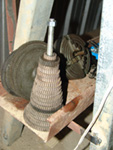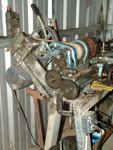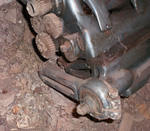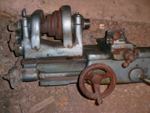Stinger's 1937 Model 415, 4 1/2' Bed, South Bend Metal Lathe
This page was created just to document the rehabilitation of a lovely machine that for all intents and purposes was lost. I say rehabilitation because it isn't a restoration. There is a truly beautiful restored 415 documented here. That's what they are supposed to look like. This one has a different story, at least for now. My father found it in the junk yard and drug it home in late 2008. Since he already has a 1954 South Bend, he generously gave this one to me. I didn't see it until Christmas when I went there but he sent me photos so I could start researching it. It looks pretty bad in the photos, the tailstock and countershaft are gone and the reverse lever is broken off, the handles of the handwheels are rusted away. It also looks badly encrusted with rust.
Right Out of the Scrap Heap
My intention wasn't to restore it, just to get it functional again. The day after we got to PA where my parents live, Missa, my sister Amy, and I were in a Panera to feed our web addiction because my parents only have dialup, and there on Ebay was the tailstock. I had been looking for months at $200 -$300 tailstocks but this one was ending in 12 min. and the bid was only $87. Twelve minutes later I had an old beat up, blue and yellow tailstock for $89. It arrived full of brass shims that made no sense because it was straight and perfectly functional, although it did have the lovely detail of a spike holding the rear handwheel on.
The great thing about 9" South Bend lathes is that there is an enormous amount of interchangeability in parts and there were tens if not hundreds of thousands of them made from the mid 30's to the mid 70's, but the countershaft was another matter. I couldn't find one anywhere so my Dad spent a lot of hours on his own 1954 model A and spun down a steel cone (also a scrap yard find) that he had laying around, into a combination countershaft and 3 speed pulley. When I got back home to LA , I put a couple fo pillow blocks that I had on it and an old air compressor pully, a unibelt and a 3/4 HP motor from a planer that I don't use. With my welded up angle iron and ship channel frame it made the ugliest countershaft imaginable but it worked. I finally had a "barely" functioning lathe. Later I found a lightweight South Bend countershaft large pulley on Ebay for $19 to replace the big cast iron one that I had originally used and got a $16 custom made neoprene transmission belt from "House of Rubber". Dad had also given me a tool post that only needed a few minor parts ground out for it and various other little things like a thread counter and a set of dogs with a back plate. I decided that the thing also needed it's own stand so I welded up a bunch of scrap iron that I had laying around. While I was at it I made a wide tool rest so that I could spin wood as well.

Change Gears
The final thing needed to make this a really useful machine was a set of change gears. Unlike later metal lathes, this one doesn't have a quick change or variable speed gearbox. You actually have to have a set of gears, called change gears, that bolt between the drive stud and lead screw on the headstock. You change the speed of the lead screw, and thus the threads per inch to be cut on a screw, or just the speed of a turning tool, by changing the gear combinations. Since my lathe has an 8 tpi lead screw you just make the ratio of the number of teeth on the driven and drive gears the same as 8 to the number of threads per inch that you want to cut (e.g. to cut 8 tpi, any pair of gears same size would work). Individual gears are easy to find on Ebay and occasionally you see a set. The only two variables that mean anything in buying these gears for a South Bend are the Diametral pitch (DP) and the bore. Some models had a 5/8" bore and others had 9/16" bore. Some models have a DP of 16 and others have a DP of 18. It's simple to calculate the DP. Just take the number of teeth plus two divided by the outside diameter of the gear in inches. Mine are a 9/16" bore with a DP of 18. To have a full set you need at least one idler gear that will either have a boss on one side about the same thickness as the gear again, or it will have a small gear there that allows it to also be used as a compound gear. After a couple of months of buying groups and singles and some trading around I finally came up with a good set of gears. I now have 100 and 80 tooth idlers and a 108/18 1-6 compound idler as well as a 54/18 idler. I also have the following change gears 116, 80(3), 72, 64, 60, 56(2), 54, 52, 48, 46, 44, 40, 36(2), 32(3), 24, 21 (with a sleeve), and the difficult to find 16. There is a threading chart below that I made up for my set of gears. It will work for any 9" with an 8 TPI lead screw (which is most if not all of them). Remeber that you really would have a hard time cutting useable 348 TPI threads because each thread would be less than 3 thousands wide, but it is a great way to get the ultra low speed needed for some cutting and finishing applications.
 The Change Gears and 4 Jaw Chuck
The Change Gears and 4 Jaw Chuck  The Headstock with Countershaft
The Headstock with Countershaft
Screw Threading Chart
Showing the correct stud and screw gears for a given TPI.
|
TPI
|
Stud
|
Screw
|
|
2
|
64
|
16
|
|
3
|
56
|
21*
|
|
4
|
64
|
32
|
|
5
|
64
|
40
|
|
6
|
64
|
48
|
|
7
|
64
|
56
|
|
8
|
32
|
32
|
|
9
|
64
|
72
|
|
10
|
32
|
40
|
|
11
|
32
|
44
|
|
11.5
|
32
|
46
|
|
12
|
32
|
48
|
|
13
|
32
|
52
|
|
14
|
32
|
56
|
|
15
|
32
|
60
|
|
16
|
32
|
64
|
|
18
|
32
|
72
|
|
20
|
32
|
80
|
|
22
|
16
|
44
|
|
23
|
16
|
46
|
|
24
|
24
|
72
|
|
26
|
16
|
52
|
|
27
|
16
|
54
|
|
28
|
16
|
56
|
|
29
|
32
|
116
|
|
30
|
16
|
60
|
|
32
|
16
|
64
|
|
36
|
16
|
72
|
|
40
|
16
|
80
|
|
58
|
16
|
116
|
|
|
With 108/18 idler
|
|
TPI
|
Stud
|
Screw
|
|
40
|
72
|
60
|
|
48
|
60
|
60
|
|
48
|
72
|
72
|
|
60
|
48
|
60
|
|
64
|
48
|
64
|
|
64
|
54
|
72
|
|
64
|
60
|
80
|
|
72
|
48
|
72
|
|
80
|
36
|
60
|
|
80
|
48
|
80
|
|
96
|
36
|
72
|
|
116
|
48
|
116
|
|
120
|
24
|
60
|
|
128
|
24
|
64
|
|
144
|
24
|
72
|
|
160
|
24
|
80
|
|
180
|
16
|
60
|
|
192
|
16
|
64
|
|
216
|
16
|
72
|
|
232
|
24
|
116
|
|
240
|
16
|
80
|
|
348
|
16
|
116
|
|
With 54/18 idler
|
|
TPI
|
Stud
|
Screw
|
|
90
|
16
|
60
|
|
96
|
16
|
64
|
|
108
|
16
|
72
|
|
174
|
16
|
116
|
|
Other Stuff
I also got tired of centering the 4 jaw chuck and found an old scroll chuck on Ebay for $40 so I couldn't pass it up. It's shown in the photo above. The lathe is powerful and smooth. I've cut out a lot of little things on it and even done a bit of threading. Maybe someday I'll give it a full restoration but for now I think it's happy just being alive again.

 The End Gears
The End Gears  Headstock
Headstock

